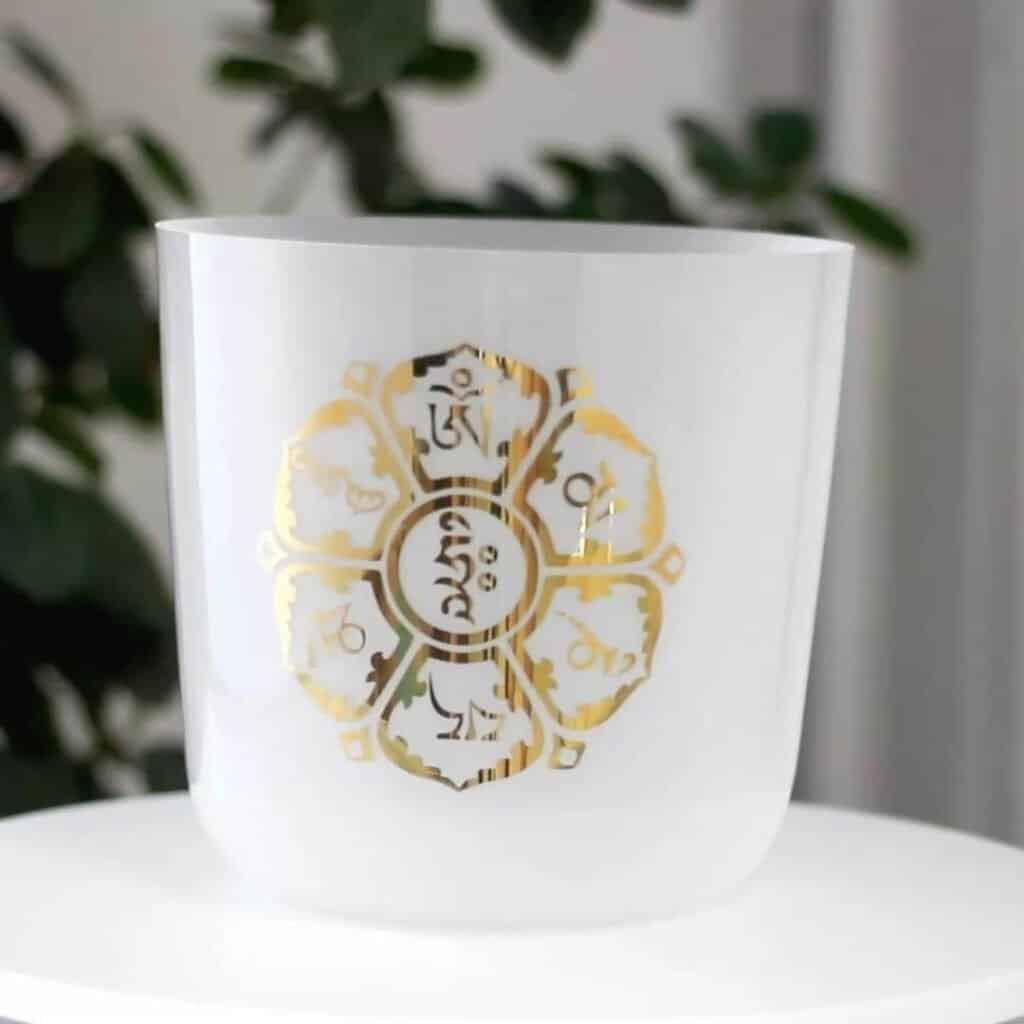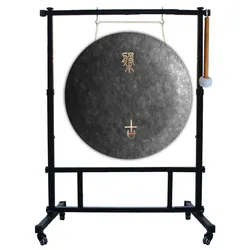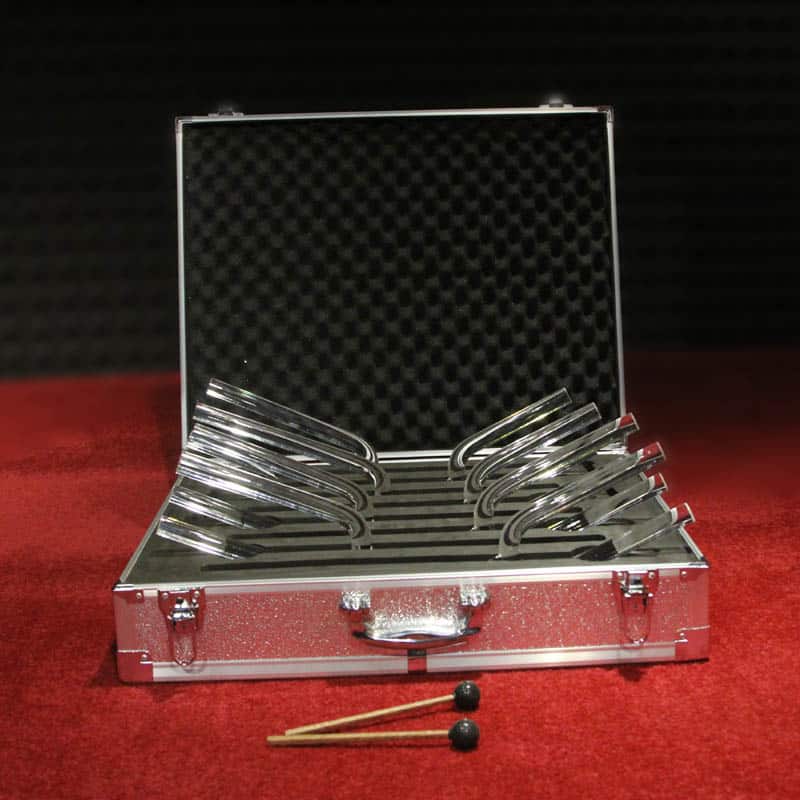Like an ancient shaman’s drum beckoning the tribe to gather, sound bath meditation calls to those seeking refuge from modern life’s chaos. You’ll discover that this practice isn’t just another wellness trend, but rather a time-tested method of achieving deep relaxation through the strategic use of resonant instruments. While you might be familiar with traditional meditation techniques, sound baths offer a unique pathway to tranquility that doesn’t require previous experience or special skills. The combination of vibration, frequency, and therapeutic sound creates an experience that can transform your approach to stress management and self-care.
Key Takeaways
�?Sound baths naturally shift brainwaves from active to relaxed states, promoting deep meditation without requiring prior experience or special skills.
�?Regular sessions reduce anxiety and depression symptoms while significantly improving sleep quality through natural circadian rhythm adjustment.
�?The practice decreases blood pressure and muscle tension by activating the parasympathetic nervous system, creating profound physical relaxation.
�?Sound vibrations provide gentle, non-invasive therapy that releases physical and emotional blockages while enhancing mental clarity and focus.
�?Sessions can be practiced individually or in groups, with minimal equipment needed for personal practice and immediate relaxation benefits.
Understanding Sound Bath Meditation

Sound bath meditation is an ancient healing practice that uses resonant instruments like singing bowls, gongs, and chimes to create immersive sonic environments. During a session, you’ll lie comfortably on a mat while sound vibrations wash over your body, helping to release tension and quiet your racing thoughts.
The practice works by engaging your brain’s natural tendency to sync with external rhythms, leading you into deeper meditative states. As you experience the layered frequencies and harmonics, your brainwaves naturally shift from beta (active thinking) to alpha and theta patterns, which are associated with relaxation and inner awareness. You’ll notice that the sounds aren’t just heard with your ears – they’re felt throughout your entire body.
What makes sound baths particularly effective is their accessibility. You don’t need any meditation experience or special skills to benefit from the practice. The sounds do the work for you, creating a cocoon of vibration that naturally draws you into a state of deep relaxation. Many practitioners report feeling refreshed, centered, and emotionally balanced after just one session, making it an excellent tool for stress management and spiritual exploration.
Benefits for Mental Health
Through regular sound bath sessions, you’ll experience notable improvements in your mental wellbeing. As you immerse yourself in the therapeutic vibrations, your brain begins to shift from its usual stress patterns into a more balanced state, allowing you to process emotions and thoughts with greater clarity. These mindfulness techniques help you develop a stronger connection between your mind and body, creating lasting emotional balance that extends beyond the session.
Sound baths offer three primary mental health advantages:
- You’ll notice reduced anxiety and depression symptoms as the harmonious frequencies help regulate your nervous system and decrease cortisol levels.
- Your sleep quality will improve remarkably because the meditative state induced during sessions helps reset your circadian rhythm and calm racing thoughts.
- You’ll develop enhanced focus and mental clarity, as regular practice strengthens your ability to remain present and mindful throughout daily activities.
The profound impact of sound therapy on your psychological wellbeing stems from its ability to create deep relaxation while simultaneously engaging your mind in a gentle, non-invasive way that promotes healing and emotional resilience.
Effects on Physical Wellbeing

Beyond its mental health advantages, sound bath therapy produces remarkable physical benefits in your body. When you’re exposed to specific sound frequencies, you’ll notice profound changes in your autonomic nervous system, leading to decreased blood pressure and reduced muscle tension. Your breathing naturally synchronizes with the resonant tones, becoming deeper and more rhythmic, which increases oxygen flow throughout your body.
You’ll experience how sound vibrations help release physical energy blockages, particularly in areas where you hold chronic tension. The sound waves penetrate deep into your tissues, creating a gentle massage-like effect that can ease joint discomfort and promote better circulation. Your heart rate typically slows down during these sessions, and you might notice improved digestion as your body enters a parasympathetic state. Many practitioners report feeling lighter and more flexible after regular sound bath sessions, as the vibrations help release fascial restrictions and promote better range of motion. The combination of different sound frequencies can also stimulate your body’s natural healing responses, potentially accelerating recovery from physical strain and reducing inflammation in various parts of your body.
Science Behind Sound Healing
The scientific foundation of sound healing rests on measurable vibrational frequencies and their interactions with human physiology. When you experience sound therapy, you’re actually engaging with complex waves of acoustic resonance that interact with your body’s natural frequencies. Your cells, tissues, and organs each maintain their own vibration frequency, and they respond to external sound waves in fascinating ways.
Research has demonstrated three primary mechanisms through which sound healing affects your body:
- Entrainment – Your brainwaves naturally synchronize with external sound frequencies, potentially shifting you from stressed beta waves to calmer alpha or theta states
- Acoustic resonance – Your body’s tissues absorb and respond to specific sound frequencies, much like how a tuning fork causes another to vibrate at the same pitch
- Vagus nerve stimulation – Certain sound frequencies can activate your vagus nerve, triggering your body’s relaxation response and reducing stress hormones
You’ll find that these scientific principles explain why you might feel deeply relaxed during a sound bath, as the frequencies work to realign your body’s natural rhythms and promote homeostasis.
Types of Sound Instruments
Several traditional instruments form the cornerstone of sound bath practices, each producing unique vibrations and therapeutic benefits. You’ll discover that different gong types, ranging from symphonic to wind gongs, create powerful resonances that you can feel throughout your entire body. These deep, rich tones work at varying sound frequencies to help release tension and promote deep relaxation.
Crystal bowls, crafted from pure quartz crystal, will produce clear, pristine tones that you’ll find particularly effective for meditation and energy balancing. When you’re seeking precise healing frequencies, you can rely on tuning forks, which deliver specific sound frequencies directly to targeted areas of your body. You’ll notice how these instruments, when struck or activated, create sustained vibrations that can help align your body’s natural rhythms.
Each instrument serves a distinct purpose in your sound healing journey. You might experience the ethereal harmonics of crystal bowls for chakra alignment, feel the transformative waves of a gong for deep cellular resonance, or use tuning forks for focused energy work. Together, these tools create a thorough approach to vibrational healing that you can customize to your needs.
Creating Your Sound Bath Space
Setting up a dedicated sound bath space requires careful attention to comfort and acoustics. When you’re creating your sound bath ambiance, you’ll need to take into account factors like room size, flooring material, and the overall layout to guarantee ideal sound resonance. Choose a quiet area away from external noise, and you’ll want to include comfortable seating or lying options like meditation cushions, yoga mats, or blankets.
Your sound bath environment should incorporate these essential elements:
- Proper lighting control through dimmable lights or candles to adjust the atmosphere as needed
- Adequate ventilation and temperature regulation to maintain participant comfort throughout the session
- Strategic instrument placement that allows you full access while maintaining a natural sound flow
When choosing instruments for your space, think about how they’ll complement each other and the room’s acoustics. You might start with a basic setup of singing bowls and chimes, gradually expanding your collection as you develop your practice. Remember to arrange your instruments within easy reach, creating an efficient workflow that won’t disrupt the meditative atmosphere you’re cultivating.
Starting a Home Practice
You’ll find it easier to start your home sound bath practice when you’ve gathered a few essential tools, including singing bowls or chimes, comfortable cushions, and perhaps some calming incense to create your sacred space. Creating consistency in your practice means selecting a specific time and dedicated area where you won’t be interrupted, allowing you to fully immerse yourself in the healing vibrations. To build a sustainable daily practice, begin with short 10-minute sessions and gradually extend the duration as you become more comfortable with the techniques and develop your own personal rhythm.
Essential Tools and Space
Creating a home sound bath practice requires three essential elements: proper instruments, a dedicated space, and basic acoustic considerations. You’ll want to set up your space with attention to sound frequency interactions and incorporate essential oils to enhance the sensory experience. When selecting your meditation area, choose a quiet room where you won’t be disturbed, and consider using soft furnishings to improve acoustics.
Your essential sound bath toolkit should include:
- Primary instruments like singing bowls, gongs, or tuning forks that produce varied sound frequencies
- Secondary tools such as chimes, drums, or rain sticks to create layered soundscapes
- Comfort items including meditation cushions, blankets, and an essential oil diffuser
The space you’ve chosen should be large enough to allow sound waves to travel and resonate properly. You’ll need to position your instruments strategically to maximize their therapeutic potential while maintaining easy access during your practice. Consider installing sound-absorbing materials on walls or adding thick curtains to prevent unwanted echo, which can interfere with the pure tones you’re trying to create.
Creating Sacred Atmosphere
A sacred atmosphere forms the foundation of any meaningful sound bath practice at home. You’ll want to transform your designated space into a sanctuary where healing vibrations can flow freely and create the deepest impact. Start by decluttering the area, removing any items that don’t contribute to your calming atmosphere, and arrange your instruments thoughtfully within easy reach.
To establish your sacred space, you can incorporate elements that engage all the senses. Light natural beeswax candles or use himalayan salt lamps for soft, warm lighting that won’t interfere with your practice. You might want to burn sage, palo santo, or gentle incense to cleanse the energy, being mindful of any sensitivities you or others may have. Comfortable cushions, blankets, and bolsters will help you maintain proper posture while remaining relaxed throughout your session. Consider adding meaningful objects like crystals, photographs, or artwork that resonates with your intention for the practice. Remember to adjust the room temperature slightly warmer than usual, as body temperature often drops during deep relaxation states.
Daily Practice Tips
Once your sacred space is prepared, starting a regular sound bath practice becomes a natural next step. You’ll want to integrate mindfulness techniques into your daily routine, allowing the healing vibrations to support your stress reduction goals. By establishing consistent practice times, you’ll create a powerful ritual that transforms your relationship with relaxation and inner peace.
To make your daily sound bath practice most effective, follow these essential guidelines:
- Start with a 10-minute session each day, preferably at the same time, and gradually increase duration as you become more comfortable with the practice
- Choose your sound tools thoughtfully, beginning with one or two instruments you’re drawn to, such as singing bowls or chimes, before expanding your collection
- Keep a practice journal to track your experiences, noting how different sounds affect your mood, energy levels, and overall sense of well-being
Remember to approach your practice with patience and an open mind, as the benefits of sound therapy often deepen over time. You’ll discover that regular sound bathing can become an invaluable tool for maintaining balance in your daily life.
Best Times for Sound Baths
The ideal time to experience a sound bath depends largely on your personal schedule and energy patterns throughout the day. Many practitioners find that prime times occur during nature’s shifting periods, such as sunrise or sunset, when your body’s rhythms are naturally changing. You’ll discover that these moments often provide enhanced receptivity to sound healing frequencies.
Early mornings, particularly between 5:00 AM and 7:00 AM, can offer profound experiences as your mind hasn’t yet accumulated the day’s mental chatter. However, if you’re not a morning person, you’ll find evening sessions between 7:00 PM and 9:00 PM equally beneficial, as they’ll help you unwind from daily stress. Your seasonal preferences may also influence timing choices, as you might prefer morning sessions during summer months when days start earlier, while winter evenings could feel more nurturing.
You’ll want to avoid scheduling sound baths immediately after meals or during times when you’re likely to be interrupted. Instead, choose a time when you can fully immerse yourself in the experience without external pressures or distractions competing for your attention.
Common Sound Bath Experiences
During a sound bath session, you’ll notice waves of peaceful vibrations flowing through your body as singing bowls, gongs, and other instruments create harmonious frequencies that help release tension and promote healing. You might experience a deep state of relaxation where your mind naturally drifts away from daily worries, while your body responds to the soothing resonance with subtle tingles, warmth, or a floating sensation. As the sound frequencies wash over you, it’s common to feel shifts in your energy, emotional release, or even moments of profound clarity as your nervous system responds to the therapeutic power of these ancient sonic tools.
Discovering Peace Through Sound
Peace washes over participants as healing vibrations fill the room during a typical sound bath session. You’ll find yourself embracing inner harmony as the therapeutic sounds guide you into a state of deep relaxation. Through auditory mindfulness, you’re able to let go of daily stresses and connect with your innermost self, allowing the resonant tones to realign your energy.
During your sound journey, you’ll experience various stages of tranquility:
- Your mind begins to quiet as the initial sounds draw you away from scattered thoughts
- Your body responds to the vibrations, releasing tension from muscles you didn’t realize were tight
- Your consciousness drifts into a meditative state where time seems to slow down
As you immerse yourself in the experience, you’ll notice how different frequencies affect various parts of your body and mind. The carefully orchestrated combination of singing bowls, gongs, and chimes creates a cocoon of sound that supports your nervous system’s natural healing response. You’ll discover that each session offers a unique pathway to stillness, as sound waves wash away stress and restore your sense of balance.
Healing Vibrations and Energy
Resonant waves of healing energy flow through your body during a sound bath, creating profound physical and emotional effects. As various instruments produce different sound frequencies, you’ll notice how each tone interacts with specific areas of your body, promoting deep relaxation and release of tension. The vibrational resonance penetrates your cells, helping to restore balance and harmony within your physical form.
During your sound bath experience, you’ll discover how these healing vibrations can affect your emotional and energetic state. When crystal bowls or gongs create sustained notes, you might feel the energy moving through blocked areas, much like a gentle internal massage. Your body naturally attunes to these therapeutic frequencies, and you’ll often notice a shift in your breathing pattern as you sync with the sounds. As the frequencies wash over you, they’ll stimulate your parasympathetic nervous system, encouraging your body’s natural healing responses. You’ll likely experience a deep sense of peace as the sound waves help clear stagnant energy and promote a state of enhanced wellbeing, making sound baths an effective tool for stress relief and energetic cleansing.
Deep Relaxation and Release
Most participants experience a profound sense of relaxation within minutes of beginning a sound bath session. As you lie comfortably, you’ll notice your body awareness increasing while your mind begins to quiet. The therapeutic sounds wash over you, creating a cocoon of vibrations that helps release accumulated stress and tension from your muscles and joints.
During this deeply meditative state, you might experience emotional release as stored feelings surface and dissolve naturally. Your breathing will likely become slower and more rhythmic, allowing you to sink deeper into a state of peaceful surrender. Many people report feeling weightless or floating, as their bodies enter a theta brainwave state similar to deep meditation.
- Your conscious mind becomes less active, allowing subconscious healing to occur
- Physical tension melts away as your nervous system responds to the soothing frequencies
- Emotional blocks often dissolve without effort, leading to natural catharsis
The deep relaxation you’ll experience during a sound bath isn’t just momentary – it can last for hours or even days afterward, helping you maintain a more balanced and centered state in your daily life.
Group Vs Solo Sessions
Choice plays an essential role when deciding between group and solo sound bath sessions, as each format offers distinct advantages. When you’re exploring group dynamics, you’ll find that shared experiences create a powerful collective energy that can enhance your relaxation journey. Solo sessions, however, allow for deeper individual focus and personal exploration in intimate settings.
Your personal preference for social interaction will greatly influence which format serves you best. During group sessions, you’ll often experience a heightened sense of community and support, while solo sessions provide uninterrupted space for self-discovery.
| Aspect | Group Sessions | Solo Sessions |
|---|---|---|
| Energy Flow | Collective vibrations | Personal resonance |
| Focus Level | Community-centered | Self-directed |
| Customization | Standardized format | Fully customizable |
| Cost | Generally more affordable | Higher investment |
| Schedule | Fixed times | Flexible booking |
You’ll want to contemplate trying both formats to determine which aligns with your relaxation goals. Some practitioners find they benefit from alternating between group and solo sessions, adapting their choice to their current needs and emotional state.
Finding Qualified Sound Practitioners
When you’re ready to work with a sound practitioner, you’ll want to start by checking their formal training and certifications in sound therapy, therapeutic music, or related healing modalities. You can evaluate their practical experience by asking about their specific areas of focus, such as singing bowls, gongs, or tuning forks, and requesting references from previous clients. It’s important to find someone who’s not only well-versed in the technical aspects of sound therapy but who also maintains professional standards and continues their education through workshops, conferences, and advanced training programs.
Verify Training and Credentials
Finding a qualified sound practitioner requires careful research into their training background and professional credentials. You’ll want to verify they’ve completed recognized certification programs and have participated in extensive training workshops that focus on sound healing techniques and safety protocols.
When verifying a practitioner’s qualifications, you should follow these essential steps:
- Request documentation of their completed sound therapy training, including certificates from accredited institutions or recognized masters in the field
- Ask about their specific experience with different sound instruments and healing modalities, verifying they’re well-versed in the tools they’ll be using
- Confirm their membership in professional sound therapy organizations and ongoing educational commitments
Don’t hesitate to inquire about their teaching methodology and approach to sound healing. A qualified practitioner should easily explain their techniques and demonstrate knowledge of contraindications. You’ll find that experienced practitioners often maintain detailed records of their continuing education and can provide references from clients or other professionals in the wellness community. Remember that while formal credentials aren’t everything, they provide a solid foundation for validating you’re working with someone who understands the complexities of sound therapy.
Assess Experience and Specialties
A sound practitioner’s expertise goes beyond basic certifications into their specific areas of practice and real-world experience. When you’re looking for the right practitioner, you’ll want to inquire about their experience levels with different types of sound healing modalities and how long they’ve been practicing professionally. Ask about their specialty techniques and the specific instruments they’ve mastered, such as singing bowls, gongs, or tuning forks.
You should also explore whether they have experience working with your particular needs or concerns. Some practitioners specialize in stress reduction, while others focus on emotional healing or physical pain management. Don’t hesitate to request examples of their past work and ask how they’ve helped clients with similar goals to yours. If they offer group sessions, find out about their experience managing collective energy and creating inclusive environments. Look for someone who regularly updates their skills through continued education and stays current with emerging sound therapy practices. Their willingness to discuss their journey, share client testimonials, and explain their approach to sound healing can give you valuable insights into their professional depth and expertise.
Integrating With Other Meditation Practices
Through mindful combination with other meditation practices, sound baths can enhance your overall wellness journey. When exploring mindfulness techniques, you’ll find that sound therapy naturally complements traditional meditation methods, enhancing focus and deepening your relaxation response. The vibrations and frequencies from singing bowls or gongs work seamlessly with breathing exercises, guided visualizations, and movement-based practices.
You can effectively merge sound baths with other meditation styles in these proven ways:
- Begin your meditation session with 5-10 minutes of sound bath immersion to quiet your mind before shifting into your preferred meditation technique.
- Use sound frequencies as anchor points during mindfulness practices, similar to how you’d focus on breath or mantras.
- Conclude traditional meditation sessions with sound healing to help integrate the experience and seal in the benefits.
This integrated approach creates a more profound meditative experience, as the sound vibrations help release physical tension while other practices address mental and emotional aspects. You’ll discover that combining these modalities creates a more thorough and transformative practice that addresses multiple layers of consciousness.
Sound Bath Safety Guidelines
When you’re setting up for a sound bath experience, you’ll need to guarantee your equipment, including singing bowls, gongs, and any electronic amplification, is properly maintained and positioned to prevent unwanted vibrations or distortions. Creating adequate space between participants and sound sources is essential, as proper distance helps optimize the therapeutic benefits while preventing overwhelming sensations. You’ll want to maintain sound levels below 85 decibels and follow the “60/60” rule: keeping volume at 60% for no more than 60 minutes to protect your hearing and guarantee a safe, restorative experience.
Proper Equipment and Setup
Creating a safe and effective sound bath experience starts with proper equipment selection and setup. You’ll want to carefully choose your sound instruments based on their acoustic resonance and quality, ensuring each piece contributes to the therapeutic environment you’re creating. When setting up your space, consider how sound waves travel and interact with different surfaces in the room.
To establish an ideal sound bath environment, follow these essential setup steps:
- Position your instruments strategically around the room, maintaining at least 6 feet of distance between powerful sound sources like gongs or singing bowls to prevent overwhelming resonance
- Create a comfortable floor space with yoga mats, blankets, and cushions arranged in a way that allows sound waves to reach each participant evenly
- Test your room’s acoustics by playing each instrument briefly and adjusting their placement to achieve balanced sound distribution
Remember to check all your equipment before each session, ensuring there aren’t any loose parts or damage that could affect the sound quality or safety. You’ll also want to keep spare mallets and strikers within easy reach during your practice.
Space and Distance Matters
Safe sound bath practices require careful attention to space and distance considerations. When you’re setting up your sound bath area, you’ll need to guarantee there’s adequate personal space between participants, allowing at least 6 feet of separation to prevent sound waves from becoming overwhelming or disorienting. This spacing helps maintain ideal distance perception and guarantees that each person can fully experience the therapeutic benefits without interference from others’ energy fields.
Your room’s dimensions will greatly impact the sound quality and overall experience. In smaller spaces, you’ll want to position sound instruments at least 3 feet away from participants to prevent excessive vibration intensity, while larger rooms may require closer positioning to maintain the desired effects. Consider the room’s acoustics carefully – hard surfaces will reflect sound waves more intensely than soft surfaces, which can affect how you arrange your space. If you’re working with multiple instruments, you’ll need to strategically position them to create balanced, overlapping waves that promote relaxation rather than tension. Remember that proper spacing isn’t just about physical comfort; it’s essential for achieving the deep meditative state that sound baths are designed to facilitate.
Follow Volume Safety Rules
Volume control serves as a cornerstone of sound bath safety, working in harmony with proper spacing to protect participants’ wellbeing. You’ll need to maintain appropriate volume levels throughout your session, ensuring that sound frequency exposure doesn’t overwhelm or cause discomfort to anyone in attendance. When you’re leading or participating in sound baths, it’s imperative to understand that excessive volume can transform a healing experience into a potentially harmful one.
- Keep sound intensity at a comfortable level where you can easily have a quiet conversation without straining your voice
- Monitor participants’ reactions and adjust volume immediately if anyone shows signs of distress or covers their ears
- Consider using a decibel meter app to maintain sound levels between 60-85 decibels, which falls within the safe listening range
Remember that different instruments produce varying sound frequencies, and you’ll need to adjust their volumes accordingly. Crystal bowls, for instance, often require lower volume levels than Tibetan singing bowls due to their penetrating frequencies. You should always trust your instincts and listen to feedback from participants to create a safe, nurturing sound environment.
Measuring Your Progress
Progress in sound bath practice can be tracked through several key indicators of your relaxation journey. You’ll want to establish personal progress indicators by maintaining detailed journal entries after each session, noting your stress levels before and after the experience. Self-assessment techniques, such as tracking your breathing patterns and heart rate, can provide concrete feedback mechanisms for measuring improvement over time.
Set specific milestone markers for your practice, focusing on both physical and emotional responses to the sound sessions. You’ll find it helpful to document personal reflections about sleep quality, anxiety levels, and overall mood changes in the days following your sound baths. Consider tracking benefits like improved focus, reduced muscle tension, or enhanced meditation abilities through a rating system you’ve created. Goal setting plays an essential role in measuring progress – establish both short-term objectives, such as attending weekly sessions, and long-term aspirations, like achieving deeper states of relaxation or maintaining prolonged periods of mental clarity. Remember to periodically review your documented experiences to identify patterns and adjustments needed in your practice.
Conclusion
You’ve discovered a powerful tool for relaxation that’s backed by science and ancient wisdom. Like Sarah, who transformed her chronic anxiety into manageable calm through weekly sound bath sessions, you’ll find that this practice offers a natural path to inner peace. Whether you’re seeking stress relief, better sleep, or emotional balance, sound therapy can become your gateway to improved wellbeing. Start your sound healing journey today, and you’ll experience the profound benefits firsthand.







